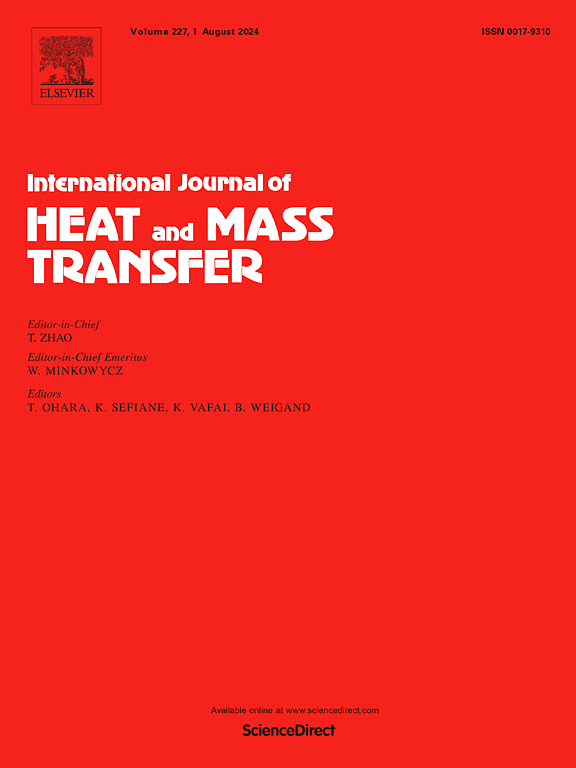The effects of rolling and heaving on flow boiling heat transfer in a 3 × 3 rod bundle channel in a natural circulation system
IF 5
2区 工程技术
Q1 ENGINEERING, MECHANICAL
International Journal of Heat and Mass Transfer
Pub Date : 2024-11-17
DOI:10.1016/j.ijheatmasstransfer.2024.126428
引用次数: 0
Abstract
Floating nuclear power plants are always influenced by sea waves. Rolling and heaving are two common conditions the plants will be subjected to. The previous rod bundle flow boiling experiments are mostly conducted at low pressure, and the results cannot be directly utilized in the nuclear power plants. Flow boiling experiments at 13–13.5 MPa and visualization experiments in a 3 × 3 rod bundle channel for rolling and heaving conditions were conducted in this research. The effects of rolling and heaving on flow boiling heat transfer coefficients (HTCs) and bubble dynamics in the rod bundle were analyzed for both subcooled and saturated boiling. The visualization results reveal that when the rolling angle is large, the void fraction of the fluid is much larger than that in the vertical static channel for most of the rolling period, and in a heaving period, the void fraction is larger than that in the static vertical channel for half the period. The experimental results show that the fluctuation amplitude of HTCs will become larger when rolling amplitude increases. When the maximum rolling angle is 10°, the average HTC during rolling process is the same with the HTC in the static vertical channel. Only when the rolling angle is 30°, the average HTC during the whole rolling process is 6.15 % higher than the static HTC. In the heaving process, the mass flux and flow boiling HTCs vary in a sine plot with the periodical movement. When the heaving amplitude becomes larger or heaving period becomes shorter, the additional driving force will increase and the mass flux fluctuation amplitude and HTC fluctuation amplitude become larger. Heaving has little effect on the time-averaged flow boiling HTCs in the rod bundle. This research widens the experimental data of high pressure flow boiling for motion conditions, and the results can be useful to the design of floating nuclear power plants.
滚动和翻腾对自然循环系统中 3 × 3 杆束通道内流动沸腾传热的影响
浮动核电站总是受到海浪的影响。滚动和翻腾是核电站经常会遇到的两种情况。以往的棒束流动沸腾实验大多在低压下进行,实验结果无法直接用于核电站。本研究在 13-13.5 MPa 压力下进行了流动沸腾实验,并在 3 × 3 棒束通道中进行了滚动和翻腾条件下的可视化实验。在过冷和饱和沸腾两种情况下,分析了滚动和翻腾对棒束中流动沸腾传热系数(HTCs)和气泡动力学的影响。直观结果表明,当滚动角较大时,流体的空隙率在滚动的大部分时间内都远大于垂直静态通道中的空隙率,而在翻腾期,流体的空隙率在一半时间内都大于垂直静态通道中的空隙率。实验结果表明,当轧制幅度增大时,HTC 的波动幅度也会变大。当最大轧制角为 10°时,轧制过程中的平均 HTC 与静态垂直通道中的 HTC 相同。只有当轧制角为 30°时,整个轧制过程中的平均 HTC 才比静态 HTC 高 6.15%。在翻腾过程中,质量通量和流量沸腾的 HTC 随周期运动呈正弦曲线变化。当翻腾幅度变大或翻腾周期变短时,附加驱动力会增加,质量通量波动幅度和 HTC 波动幅度也会变大。翻腾对杆束中的时均流沸腾 HTC 影响不大。该研究拓宽了运动工况下高压流沸腾的实验数据,其结果可用于浮动核电站的设计。
本文章由计算机程序翻译,如有差异,请以英文原文为准。
求助全文
约1分钟内获得全文
求助全文
来源期刊
CiteScore
10.30
自引率
13.50%
发文量
1319
审稿时长
41 days
期刊介绍:
International Journal of Heat and Mass Transfer is the vehicle for the exchange of basic ideas in heat and mass transfer between research workers and engineers throughout the world. It focuses on both analytical and experimental research, with an emphasis on contributions which increase the basic understanding of transfer processes and their application to engineering problems.
Topics include:
-New methods of measuring and/or correlating transport-property data
-Energy engineering
-Environmental applications of heat and/or mass transfer

 求助内容:
求助内容: 应助结果提醒方式:
应助结果提醒方式:


